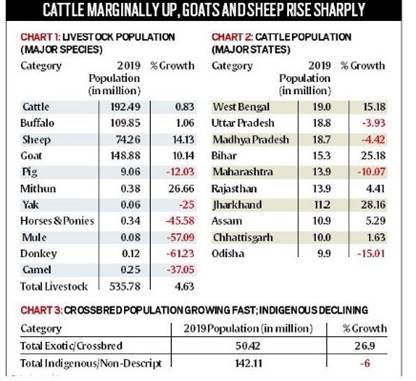



NITI Aayog launches India Innovation Index 2019
NITI Aayog with Institute for Competitiveness as the knowledge partner released the India Innovation Index (III) 2019. Karnataka is the most innovative major state in India. Tamil Nadu, Maharashtra, Telangana, Haryana, Kerala, Uttar Pradesh, West Bengal, Gujarat, and Andhra Pradesh form the remaining top ten major states respectively.
- It will help in making India innovation leader in the world.
- Cluster-based innovation should be leveraged upon as the focal point of competitiveness.
- The index is a great beginning to improve the environment of innovation in the country as it focuses on both the input and output components of the idea.
- The index is a good effort to benchmark the performance of the state with each other and promote competitive federalism.
- The aim is to create a holistic tool which can be used by policymakers across the country to identify the challenges to be addressed and strengths to build on when designing the economic growth policies for their regions.
The index attempts to create an extensive framework for the continual evaluation of the innovation environment of 29 states and seven union territories in India and intends to perform the following three functions:
- Ranking of states and UTs based on their index scores.
- Recognizing opportunities and challenges
- Assisting in tailoring governmental policies to foster innovation.
The India Innovation Index 2019 is calculated as the average of the scores of its two dimensions - Enablers and Performance.
The Enablers are the factors that underpin innovative capacities, grouped in five pillars:
- Human Capital
- Investment
- Knowledge Workers
- Business Environment
- Safety and Legal Environment.

The Performance dimension captures benefits that a nation derives from the inputs, divided in two pillars:
- Knowledge Output
- Knowledge Diffusion.
- The index shows that the innovation ecosystem of the country is strong in south and western parts of India.
- Three of the top five major states are from southern India.
- Delhi and Haryana seem to be an exception to this rule and seem to be doing well on the Index.
- Maharashtra performs the best in the dimension of Enablers.
- Karnataka’s number one position in the overall ranking is partly attributed to its top rank in the Performance dimension.
- Increasing the spending on research and development.
- Improving the capability of top rung educational institutions in the country to produce greater innovation outputs.
- Need for greater coordination and collaboration between the industry and educational institutions for enhancing innovation capability.
- Cluster development programs are also an area in need of greater coordination and can benefit from a more open collaborative approach.
- The industrial policies at the state level should focus more on innovation.
Source: PIB
The Department of Animal Husbandry & Dairying released the results of the latest livestock census, which provides headcount data of domesticated animals in the country.

- Under the livestock census, various species of animals possessed by households, household enterprises or non-household enterprises and institutions are counted at site — both in rural and urban areas.
- It covers all domesticated animals in a given period of time.
- India has been conducting livestock censuses periodically since 1919-20.
- The last livestock census was conducted in 2012.
- The census tracks the population of various species of domesticated animals such as cattle, buffalo, mithun, yak, sheep, goat, pig, horse, pony, mule, donkey camel, dog, rabbit and elephant and poultry birds (fowl, duck, emu, turkeys, quail and other poultry birds).
- For the first time, livestock data has been collected online through tablet computers.
- In 2019, the total livestock population is 535.78 million; cattle (192.90 million) is the largest animal group in the country followed by goats (148.88 million), buffaloes (109.85 million), sheep (74.26 million) and pigs (9.06 million).
- The total livestock population has registered a growth of 4.6 per cent over the last census in 2012 (512.06 million).
- However, the numbers of some animals such as pig, yak, horses and ponies, mule, donkey and camel have come down drastically.
- Latest census also shows an eastward shift as West Bengal overtakes UP with highest cattle count.
- Indigenous cattle population is further down while crossbred numbers have gone up.
- Due to continuous fall in productivity, indigenous breeds of cattle have become liabilities for farmers, forcing them to desert the unproductive cows.
- Unlike cows, other animals become unproductive, they can be sold and slaughtered for further processing.
- Experts believe this could have long term health and environmental impacts because the milk of indigenous breed has higher nutritional value than that of crossbreeds.
- There is a danger of losing these indigenous breeds, which have been developed and sustained by generations from time immemorial.
Reference: https://indianexpress.com/article/explained/reading-the-livestock-census-2019-india-6075270/
The Organisation of Economic Co-operation and Development (OECD), the global grouping of 36 mostly high-income, free-market economies, has released a consultation paper proposing changes in the rules for taxing Internet giants such as Facebook, Apple, Google, Amazon, and Netflix.
The proposal, called “Unified Approach”, is to shift the standard of taxation from physical presence to sales in a particular market. That is, the companies will have to pay more taxes in the markets in which they sell more.
- Highly “digitalised businesses” can operate remotely and have high profits.
- Many companies have moved their source of profits to countries with low tax rates, such as Ireland.
- The proposal would give new taxing rights to countries with many users of such business models.
- India is among countries that rely on a “significant economic presence model”.
- In April, the Income-Tax Department proposed new taxing norms for MNCs, with a different weightage for digital companies, incorporating the number of users in India.
- The key to the proposal is that the “new nexus” would be based on sales.
- The new nexus rule would address this issue by being applicable in all cases where a business has a sustained and significant involvement in the economy of a market jurisdiction, such as through consumer interaction and engagement, irrespective of its level of physical presence in that jurisdiction.
- The proposal suggests designing the new rule and determining significant involvement in the jurisdiction by assigning a revenue threshold in the market.
- It also means the rules would apply not just to large tech multinationals, but any firms with a presence online, such as automakers.
- The proposal leaves many questions unanswered — in particular, how much profit should be reallocated to the country.
- The choice of this amount will ultimately be the result of a political agreement that needs to be acceptable to all members of the Inclusive Framework, small and large, developed and developing.
- G20 finance ministers are expected to discuss the proposal this week, and countries in favour of new laws could begin negotiations thereafter.
Common Cause’s recent survey on the Status of Policing in India is said to have affirmed that the black sheep in the police force find nothing wrong with beating up criminals to extract a confession.
- India signed the UN Convention Against Torture on October 14, 1997, but is yet to ratify it by enacting the law on torture.
- Any custodial or other case of death in police custody is enquired into by a magistrate and in some cases, a judicial enquiry can also be ordered.
- Complaints against policemen have been filed in courts, which have taken severe action in such cases.
- Installation of CCTV cameras covering hawalat rooms in police stations has been made mandatory.
- The National Human Rights Commission acts as the watchdog of human rights.
- Police stations in outlying rural areas lack even the basic technology, forensic aid and materials for crime detection.
- Many of them are located in signal gap zones, where mobile phones barely work and internet connectivity is weak or non-existent.
- The roads are un-motorable.
- A single big police station looks after 70 to 80 villages in large states.
- Crime is rampant.
- The building infrastructure in many cases is still poor and unliveable — forget about interrogation or detention cells.
- With a severe manpower deficit, India’s police force is grossly overworked.
- The heavy pendency of work is coupled with brazen political interference.
- Work stress is inordinately high and the quality of life poor and demotivating.
- The urgency to improve the crime detection rate is a matter of constant worry.

- All police stations need to be provided with modern-day amenities and connectivity.
- A dire need is the state-of-the-art technology and equipment to promote hassle-free interrogation and crime detection.
- The police force needs to be trained at regular intervals and special training should be imparted to the state police personnel by the CBI on questioning suspects.
- Separation of the law and order and investigation wings at police stations.
- Strengthening the prosecution apparatus and provision of legal advisors in the district police set up.
- Sustained focus on Ease of Doing Policing and measures for empowering the police within a well-established accountability framework could prove to be the biggest step towards reducing this practice.
- The recruitment process for the police has to be equipped with modern psychoanalytical tools to shun the entry of those with a grain of brutality.
- It must implement the Supreme Court’s directive on setting up a Police Complaints Authority in every state of India.
- Ratification of the UN convention against torture needs to be done in letter and spirit.
- Unless we upgrade our infrastructure, ramp up our capacities, strengthen our police force, enacting the Prevention of Torture Bill will be just another exercise of official compliance to free our conscience.
The Naga peace talks are back in the headlines. The scramble started on August 17 when the interlocutor for the talks, and now governor of Nagaland, R N Ravi disclosed that the prime minister has asked him to conclude the talks in three months.
Last year, Ravi told a parliamentary committee that the framework agreement of 2015 was signed after the National Socialist Council of Nagalim (IsakMuivah).
- Abrogation of special status for Jammu and Kashmir under article 370 provoked anxiety in Nagaland and other north-eastern states, most of which are endowed with different levels of special status under different sections of Article 371.
- The demands for a separate Naga flag and constitution — the very same things that were taken from Jammu and Kashmir — were what had stalled the talks.

Explicit aims of the Naga movement — from Phizo to Muivah — were sovereign statehood and territorial integration.
- Sovereignty was claimed on the basis of prior sovereign existence and difference, which is today expressed in terms of “uniqueness”.
- Second, the “artificial boundaries” separating the Nagas will be dismantled and be placed under one administration.
- ISCN-IM has already gave up the demands of separation or integration of boundaries.
- When the symbolic yet significant demands for a flag and constitution are not acceded to, what are they left with?
- The taste of relative peace since 1997 emboldened the people and they are unlikely to be happy with renewed violence.
- Against the NSCN-IM’s objections, other Naga groups are asserting themselves and the government is happy to indulge them.

© 2025 iasgyan. All right reserved